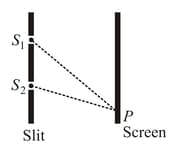Analytical Treatment of Interference Bands
Important Questions on Analytical Treatment of Interference Bands
A thin plastic sheet of refractive index is used to cover one of the slits of a double-slit arrangement. The central point on the screen is now occupied by what would have been the bright fringe before the plastic was used. If the wavelength of light is , what is the thickness (in ) of the plastic?
A thin mica sheet of thickness and refractive index is introduced in the path of the first wave. The wavelength of the wave used is . The central bright maximum will shift
Two interfering waves are arriving at a point on a screen with a path difference of . The path difference is . The wavelength of light is _____. Is the point dark or bright?
The optical path difference between the two identical waves arriving at a point is . If the wavelength of light used is , then the number of dark fringes passing through that point will be
In Young's double-slit experiment, two wavelengths and are used to obtain interference fringes. If the bright band due to coincides with bright band due to , then the value of is
In Young's double-slit experiment, the slits are apart and are illuminated by photons of two wavelengths and . At what minimum distance from the common central bright fringe on the screen from the slit will a bright fringe from one interference pattern coincide with a bright fringe from the other?
In Young's double-slit experiment, slits are separated by and the screen is placed away. A beam of light consisting of two wavelengths and , is used to obtain interference fringes on the screen. The least distance from the bright fringes due to both the wavelengths coincide is
The two slits are apart from each other and illuminated with a light of wavelength . If the distance of the screen is from the slits, then the distance between the third dark fringe and the fifth bright fringe is
In the double-slit experiment, the angular width of the fringes is for the sodium light . In order to increase the angular width of the fringes by , the necessary change in the wavelength is
In Young's experiment, two coherent sources are placed apart and the fringes are observed one metre away. If it produces the second dark fringe at a distance of from the central fringe, the wavelength of monochromatic light used would be
The maximum intensity in Young's double slit experiment is Distance between the slits is where is the wavelength of monochromatic light used in experiment. What will be the intensity of light in front of one of the slits on a screen at a distance ?
In a Young's double slit experimental arrangement shown here, if a mica sheet of thickness and refractive index $\mu$ is placed in front of the slit $\mathrm{S}_{1},$ then the path difference

In Young's double-slit experiment, an interference pattern is obtained on a screen by a light of wavelength coming from the coherent sources $\mathrm{S}_{1}$ and $\mathrm{S}_{2}$. At certain point $P$ on the screen, third dark fringe is formed. Then the path difference $S_{1} P-S_{2} P$ in microns is
Two slits separated by a distance of are illuminated with red light of wavelength . The interference fringes are observed on a screen placed from the slits. The distance between third bright fringe and the fifth dark fringe on the same side is equal to
In the double-slit experiment, the distance of the second dark fringe from the central line is . The distance of the fourth bright fringe from the central line is
Two sources of light apart are placed at a distance of and wavelength of light is . The phase difference between the two light waves interfering on the screen at a point at a distance from central bright band is
Two wavelengths of light and are sent through Young's double slit apparatus simultaneously. If order bright fringe of coincide with the fourth order bright fringe for then
If a thin transparent plate is introduced in the path of interfering waves, then entire fringe
The distance of $n^{\text {th }}$ bright band from centre band is given by,
In interference of light, bright bands occur on the screen at

